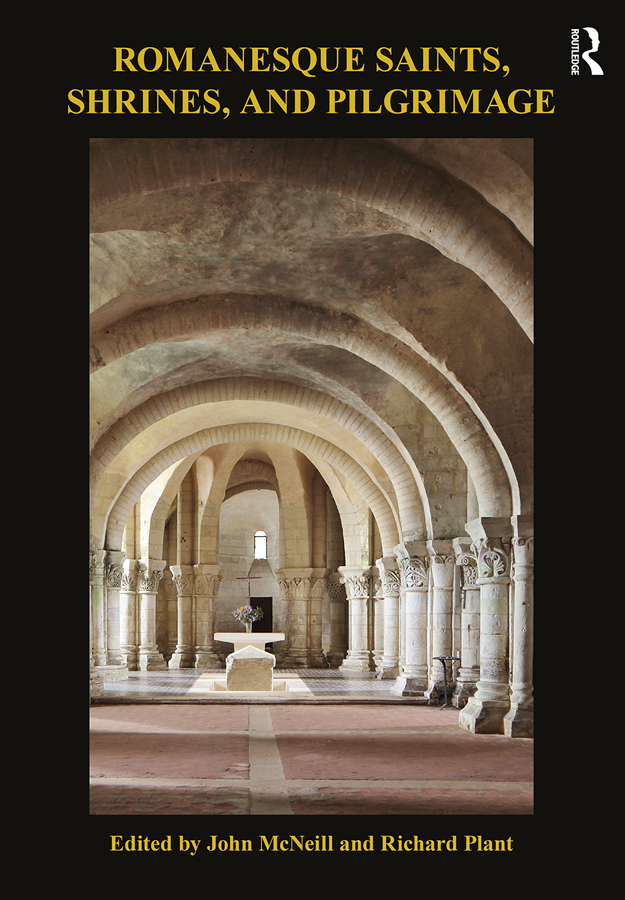The 23 chapters in this volume explore the material culture of sanctity in Latin Europe and the Mediterranean between c. 1000 and c. 1220, with a focus on the ways in which saints and relics were enshrined, celebrated, and displayed.
Reliquary cults were particularly important during the Romanesque period, both as a means of affirming or promoting identity and as a conduit for the divine. This book covers the geography of sainthood, the development of spaces for reliquary display, the distribution of saints across cities, the use of reliquaries to draw attention to the attributes, and the virtues or miracle-working character of particular saints. Individual essays range from case studies on Verona, Hildesheim, Trondheim and Limoges, the mausoleum of Lazarus at Autun, and the patronage of Mathilda of Canossa, to reflections on local pilgrimage, the deployment of saints as physical protectors, the use of imagery where possession
of a saint was disputed, island sanctuaries, and the role of Templars and Hospitallers in the promotion of relics from the Holy Land.
The book will serve historians and archaeologists studying the Romanesque period, and all those interested in material culture and religious practice in Latin Europe and the Mediterranean c.1000–c.1220.
Table of Contents
Chapter 1: Neil Stratford, The Lazarus Mausoleum at Autun Revisited
Chapter 2: Barbara Franzé, A re-præsentatio of Royal and Holy Bodies: The Monumental Tombs of Vienne Cathedral in their Liturgical Settings
Chapter 3: Susanne Wittekind, Heribert and Anno II of Cologne: Two Saintly Archbishops, their Cult, and their Romanesque Shrines
Chapter 4: Gerhard Lutz, The Canonisation of Bernward and Godehard: Hildesheim as a Cultural and Artistic Centre in the 12th and 13th Centuries
Chapter 5: Meredith Fluke, A Garland of Saints: Romanesque Verona and the Evocation of Rome
Chapter 6: Arturo Carlo Quintavalle, The Geography of Death: Tombs of Saints and Nobles in the Lands of the Canossas
Chapter 7: Rose Walker, A Satirical Itinerary of Holy Bodies? Recommendations from The Pilgrim’s Guide
Chapter 8: Richard Gem, The Pilgrimage Church of St Martin at Tours: The Building Project of the Treasurer Hervé (c. 1001–1022) and its Context
Chapter 9: Claude Andrault-Schmitt, Saint Martial of Limoges and the Making of a Saint
Chapter 10: Deborah Kahn, Local Hero: Saint Eusice at Selles-sur-Cher
Chapter 11: John McNeill, Extra-Mural Developments: The 11th-Century Reconstruction of St-Eutrope at Saintes
Chapter 12: Michele Luigi Vescovi, Stone, Image, Body: Constructing the Memory of Saint Dionysius in Regensburg
Chapter 13: Marta Poza Yagüe, Byzantine Echoes at the End of the 11th Century in the Kingdom of Aragon: Sancho Ramirez and the Relics of Saint Demetrios of Thessaloniki, Fact or Historiographic Fiction?
Chapter 14: Manuel Castiñeiras, Inventing a New Antiquity: The Reliquary-Altar Depicting the Martyrdom of Saint Saturninus at Saint-Hilaire d’Aude
Chapter 15: Elizabeth Valdez del Álamo, With Faithful Mind: The Pilgrimage to Santo Domingo de Silos
Chapter 16: Jeremy Knight, Bradanreolice, Burryholms, and Barry Island: Saints, Shrines and Island Pilgrimage Centres in the Severn Estuary
Chapter 17: Ryan Lash, Leo on the Margins? Reform, Romanesque, and the Monastery on Inishark Island, Ireland
Chapter 18: Béla Zsolt Szakács, Three Hungarian Shrines from 1083: Canonisation, Politics, and Reform
Chapter 19: Øystein Ekroll, The Royal and Christlike Martyr: Constructing the Cult of Saint Olav, 1030–1220
Chapter 20: Tomasz Węcławowicz, The “Forest of Symbols” on the Romanesque Bronze Doors at Gniezno Cathedral Church
Chapter 21: Montserrat Pagès i Paretas, Images in the Bayeux Tapestry and Rodes Bible: Reliquaries, Models, and Meaning
Chapter 22: Gaetano Curzi, Templars, Cults, and Relics: The Cleveland Reliquary of the True Cross
Chapter 23: Javier Martínez de Aguirre, Templars, Hospitallers, and Canons of the Holy Sepulchre on the Way of Saint James: Building at the Service of Lay Spirituality
